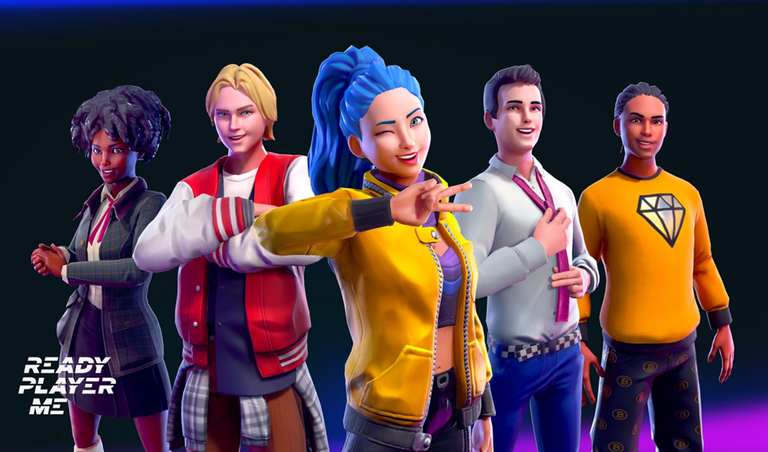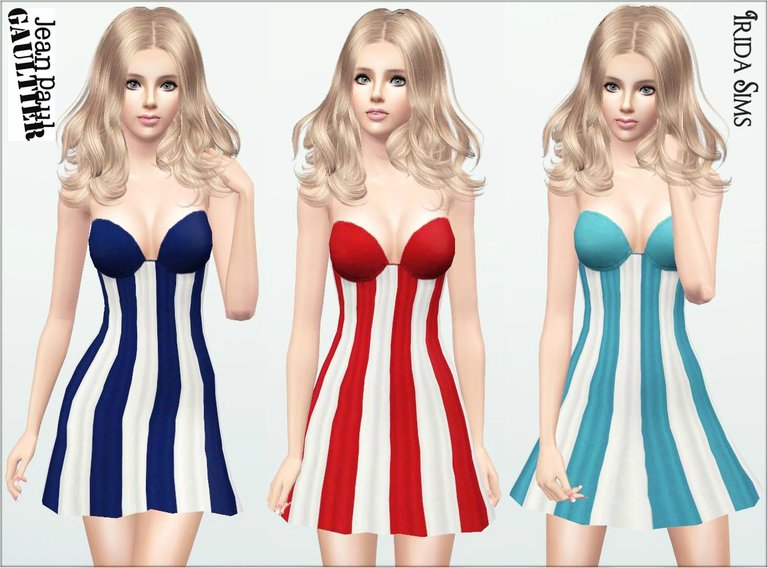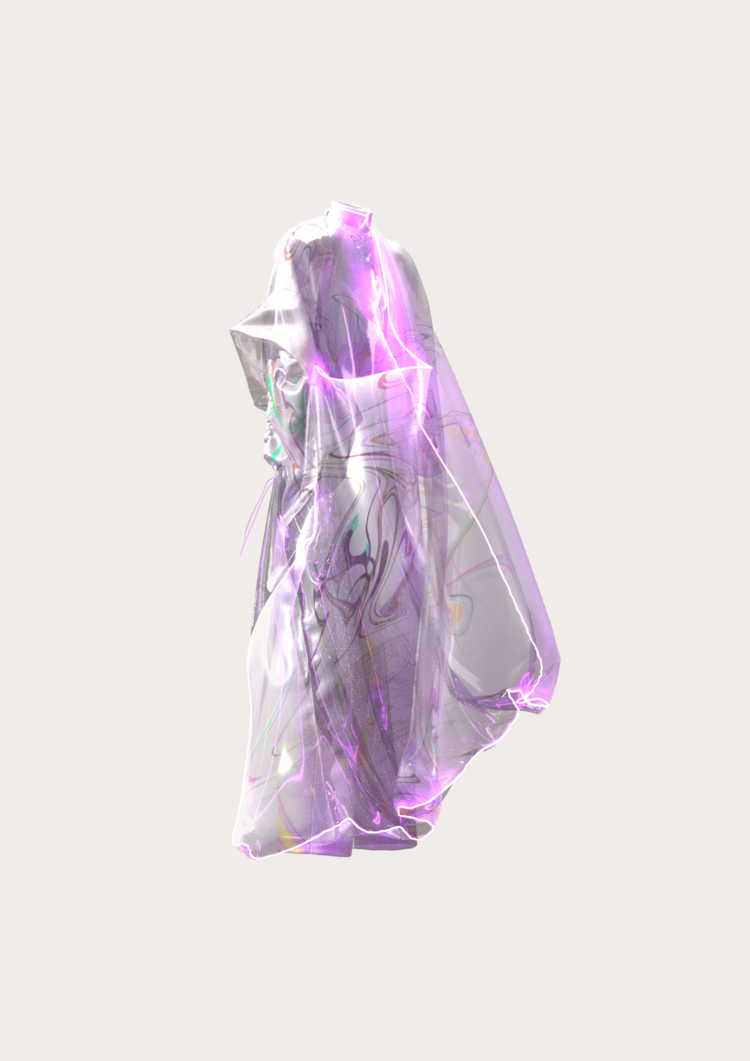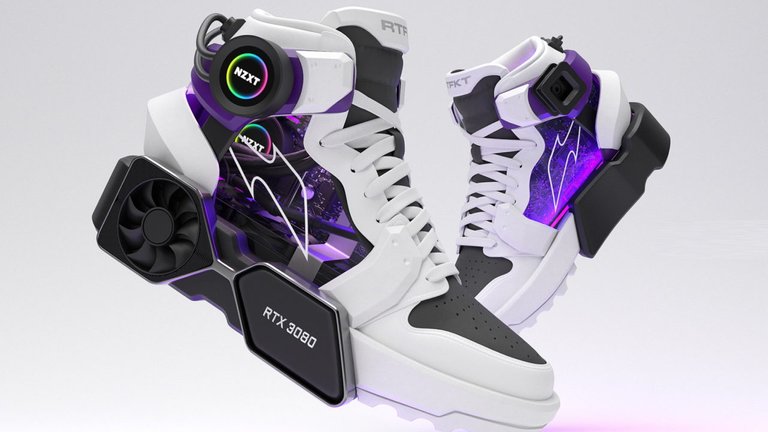Hey Hive Peeps
I hope you are all doing ok during these crazy times. Thank you for taking the dive into my personal rabbit hole on the topic of digital fashion. I think it makes sense to start things off by talking a bit about my opinion and experiences on the metaverse first as I think it's an important factor when it comes to the world of digital fashion and the part it will play in the future.

Image Source: Ready Player Me
The metaverse is a very tricky topic to discuss as there are so many different opinions as to what it is and how it relates to the current state of things where today's internet ecosystem is concerned. The Metaverse idea is generally something that has become incredibly overhyped by the corporate world which has been further exacerbated by various people and groups across the internet as a whole. I think it's fair to say that the ideas put across in the Hollywood movie Ready Player One are still nothing but a far fetched fantasy no matter how much people would love to believe the opposite. Technically a metaverse is to quote the dictionary.com meaning:
“a theoretical or emergent networked online space with digitally persistent environments that people inhabit, as avatars, for synchronous interactions and experiences, accessing the shared virtual space through virtual reality, augmented reality, game consoles, mobile devices, or conventional computers.”
To me, it's just the natural progression of the internet that will eventually occur some time in the future. Anyone who has actually spent any time on any of the currently available hosted VR platforms will be very aware of just how early we are in relation to what the metaverse may one day become. I don't know about you but in most cases I found them to be somewhat under populated and lacking in utility for the most part. There were some exceptions though.
Some of the VR platforms that I have investigated so far are VR Chat, AltSpaceVR, Horizon Worlds and Sansar. In an upcoming post, I will be looking into the platforms in greater depth as well as some of the new upcoming platforms that are still in the development phase but that's a whole other rabbit hole for another day.
That being said, the one thing that I do see that is very real and is very much available now is a whole lot of potential which leads me to the topic of Digital Fashion.
I think that given the mistakes that were made by so many in the early days of the WEB 2.0 Social Media revolution, it's fair to say that many have learned from those mistakes and are now wise enough to know how beneficial it can be to be early to a new technological frontier like Social Media once was. 1st mover advantage can be key in today’s online world.
One of the industries that have already started making some very bold moves in relation to the NFT and Metaverse space is the fashion world, which as I'm sure many of you may agree is a space that has lacked any notable innovation for quite some time. There are still only a handful of companies and designers that have made the leap so far and some are by no means small.
The fashion industry as a whole has been plagued by sustainability and environmental issues for quite some time so given the sustainable nature of digital fashion, it could be the beginning of a much-needed turning point for the whole industry.
The nature of how the digital fashion production line works is something that is now beginning to change how regular everyday fashion garments are designed and produced. Companies are now starting to adopt a digital-first ethos when it comes to updating their current design process. This is something that is far more sustainable in nature compared to the old models.
Thanks to apps like CLO 3D and MARVELOUS DESIGNER clothing can now be designed using 3d scale models that enable garments to be produced in a digital format as well as be sent to a manufacturer to be produced in a physical format.
The clothing designed in CLO 3D and MARVELOUS DESIGNER can also be used in conjunction with the Metahumans from Unreal Engine which can then be animated and used to create a virtual fashion show which is something that Gary James McQueen the nephew of the late Alexander McQueen has been making great strides with recently.
This design process greatly reduces a huge amount of waste that was previously generated by previous design methods. Another sustainability factor that digital fashion could address is the use of clothing by social media influencers. It is becoming a well-known problem that many social media influencers often purchase outfits from stores just to wear for one post and then return them the next day for a full refund to avoid paying for them. In some cases, people will purchase an item in a number of colours and sizes, keep the ones they want and return the rest. Unfortunately, a lot of stores have policies that prevent them from relisting these items for sale even at a discounted price so the end result can often be that they get burned or even sent to a landfill site. In the United States alone as many as 30 million items end up in this category every year.

Image Source: The Sims
Digital fashion actually got started a lot earlier than most people think. Back in 2007 H&M and Jean Paul Gautier released what was probably the first big brand entry into digital fashion and that was via The Sims game.
The first brave leap into the NFT based digital fashion space was made by the Digital Only fashion house The Fabricant that was founded by Kerry Murphy, Amber Jae Slooten and Adriana Hoppenbrouwer back in 2018. Their sustainability mission statement as quoted on their site is as follows:
“The Fabricant is the world’s first digital fashion house, making innovative and compelling 3D garments and fashion narratives that are entirely non-physical. Among our founding principles is the belief that fashion should waste nothing but data and exploit nothing but the imagination. Through our work we harness the power of the digital realm to build an inspiring and collaborative fashion future that operates beyond physical boundaries. We are committed to the creation of a new fashion perspective that revolutionises industry systems, and makes self expression through digital clothing a sustainable way to explore personal identity.”
The Fabricant were also the first fashion house to sell a digital garment as an NFT on the blockchain via an auction for a staggering $9500 in 2019. This was to become a landmark event that really paved the way for the industry as a whole in the digital fashion space. The Fabricant have also recently started a collaboration with the founders of The World of Women NFT collection that can be seen Here. The Fabricant are currently in the process of launching yet another groundbreaking platform called The Fabricant Studio which will allow users to design create and mint their own digital fashion NFTs via the FLOW blockchain which can then be ported to your digital avatar and used across supported platforms via your wallet or even traded on NFT platforms such as Opensea.

Image Source: The Fabricant
If you are interested in learning more about this groundbreaking project and seeing the creation in its full glory then Click Here
The Dematerialised is another digital clothing brand that was very early to the space. This brand was founded by Karinna Nobbs and Marjorie Hernandez in December 2020 and is powered by the Lukso Blockchain. The digital fashion items that The Dematerialised sell through their store can also be used in the same way as previously mentioned for The Fabricant. They can also be traded on NFT platforms or ported to virtual avatars for use in the metaverse and gaming platforms.
At this point, I think it's worth talking a bit about the Lukso Blockchain given its connection to The Dematerialised brand. Marjorie Hernandez also Co-Founded the Lukso Blockchain with her husband Fabian Vogelsteller, who is well known in the crypto community as the co-creator of the ERC20 token along with Vitalik Buterin. Lukso was created with the main purpose of solving the problems caused by counterfeit luxury products in the retail industry. Their advisory board lists people from major brands like Instagram, Nike and Chanel.
Another notable landmark event which garnered a huge amount of media attention was the limited edition sale by digital sneaker brand RTFKT in collaboration with upcoming artist and designer Fewocious. RTFKT was founded by Benoit Pagotto, Chris Le and Steven Vasilev
In 2020
They released 620 pairs of limited edition digital sneaker designs as NFTs which completely sold out in 5 minutes and earned them $3.1 Million Dollars. Shortly after this sale RTFKT were acquired by NIKE to be the backbone of their future Digital Sneaker production department.
The main difference between RTFKT/NIKE and a lot of other digital fashion creators and outlets is that they are also looking to capitalise on what is now being called the Phygital product space where a percentage of their Digital Sneakers designs that they produce will be able to be purchased in both physical and digital formats in a single purchase. Clearly, some of their designs just cannot be realised in this way due to their outlandish digital nature so in these cases they will be able to be used as a Snapchat filter or just traded as NFTs.

Image Source: RTFKT
Another interesting and notable event that took place recently was the Metaverse Fashion Week which took place at the new Fashion District created by Boson Protocol on the Decentraland platform and hosted brands such as Tommy Hilfiger, Estee Lauder, Bulova, Selfridges, Dolce&Gabbana and Forever 21. During the event, there were also a number of catwalk fashion shows and Q&A panels that included people from all the featured brands. Overall there were as many as 70 different fashion brands that hosted spaces selling and giving away a variety of different fashion based NFTs across the fashion district during the course of the fashion week event. This was all made possible by the new Boson Protocol E-commerce payments platform that was designed specifically for this purpose and is also one of the first of its kind.
One of the brands featured at The Metaverse Fashion Week is is a company called Dress X.
They are an Augmented Reality based digital fashion brand created by Ukrainian born Daria Shapovalova. This is another digital fashion brand that was created in part to help solve the sustainability issues surrounding the fashion industry.
The next important factor that will become an important part of digital fashion is the virtual avatar. Our digital representation of ourselves that we can use on everything from current social media and gaming platforms to the future metaverse platforms. Like all things in this space it's still early days where virtual avatars are concerned but as with digital fashion there are a couple of notable avatar creation platforms that are definitely worth mentioning.
The first is Ready Player Me. This is a fairly simple avatar creator that you can upload an image of yourself which it then uses to create an approximate likeness. It’s predominantly created for developers but works well for end-user needs too.
Their platform has partnerships with platforms like VRChat which enables your avatar to be ported directly onto their platform. They also allow you to download the avatar as a .glb file which can then be used anywhere that it's supported. They also have partnerships with content creators like RTFKT and the Larva Labs NFT company for the owners of the Crypto Punks collection.
The second is Zepeto. This is definitely designed for a younger Gen Z demographic. It is infinitely more complicated than Ready Player Me as it involves lots of complex animation aspects as well as an extensive clothing and accessories marketplace. There are multiple apps that fall under the Zepeto brand. The first being their avatar creator and the second being their world creator.
In conclusion, the digital fashion industry is destined to be absolutely huge. Given its close relationship with the NFT and gaming industries and the unprecedented growth that we have already seen there over the last few years, I think it's fair to say that the future will be incredibly bright and exciting. I would also like to leave you with a few stats to think about so you have an idea of the scale of whats to come.
In Q3 2020 the NFT sales growth was up to $28 million. Q4 2020 $52.8 million
Q1 2021 $1.2 billion Q2 $1.3 billion and Q3 2021 $10.7 billion.
Fortnite brings in $1billion per year just in player skins alone.
In the gaming industry in general players already spend on average $100 billion per year on virtual goods.
We are already at this level and things have barely begun.
If you did manage to get this far, thank you for reading my post. I hope you enjoyed learning about the world of digital fashion.
Excellent article, I'm still very confused about this world of metaverse, with this you talk about fashion, the only thing that makes sense to me is the fact of not wasting materials that as you say end up stopping in a landfill or burned, I hope to gradually learn and understand more about this topic that every day invades us more.
Excelente artículo, aun estoy muy confundida en cuanto a este mundo del metaverso, con esto que hablas de la moda, lo único que tiene sentido para mí es el hecho de no desperdiciar materiales que como dices terminan parando en un vertedero o quemados, espero poco a poco ir aprendiendo y entendiendo mas de este tema que cada día nos invade mas.
Thankyou. Yeah, the whole metaverse thing is definitely confusing. I think that the main reason for this is because it doesn't really exist yet, at least not in the way that it is being portrayed by many. The majority of things that are being marketed as being metaverse platforms are really just online multiplayer gaming platforms where you can create characters, buy clothes for them and then share digital experiences in a social setting with your friends. The main difference is that the community co-creates the mini-worlds/experiences that are available in a lot of cases. The corporate world needs us to believe that the metaverse is here so that they can start selling us their products which they can then use to deliver a new level of advertising now. In my opinion, the metaverse won't really start to get going until the technology catches up a bit more. When AR(Augmented Reality) glasses start to become available at affordable prices we will start to see a lot of the apps and tech that are currently being developed actually come into fruition. At that point, we will probably be able to put on a pair of smart glasses and be able to see an entirely digital world around us that will be overlayed over the existing one. You will be able to see people walking down the street wearing digital outfits and accessories and I hate to say it but probably also a lot of digital billboards infecting our spaces with advertising for products that we don't want or need if current social media trends are anything to go by. I think it's fair to say that what we are seeing now is really just a foundation that is being built so when the tech does catch up everything will be in place to deliver the level of content that will be required to deliver an optimal experience. I think the best comparison I can make is to when the early social media and video sharing platforms got started around 2005-2007 the smart phone technology was still in its infancy so it couldn't really deliver the experience at a level that was really useful to people, also the internet bandwidth was also lacking so even streaming a video in decent quality on a mobile device was expensive and challenging for the majority of us. Unlimited data packages were pretty much unheard of and the data offerings that were available were really not that great and offered terrible value compared to today's world. I hope this helps to shed a bit of light on the metaverse and its current state. In one of my next posts, I will be focusing entirely on this subject so I will do my best to try and make as much sense of it as I can and cover as much as possible.😀 🙏 ❤️
😉👍
Thank you for sharing this great content, You have been manually Upvoted by @skylinebuds
!PIZZA
!LOLZ
!LUV
!HBITS
!PGM
Posted using 1UP - Play2Earn & NFTs
BUY AND STAKE THE PGM TO SEND A LOT OF TOKENS!
The tokens that the command sends are: 0.1 PGM-0.1 LVL-2.5 BUDS-0.01 MOTA-0.05 DEC-15 SBT-1 STARBITS-0.00000001 BTC (SWWAP.BTC)
Discord
Support the curation account @ pgm-curator with a delegation 10 HP - 50 HP - 100 HP - 500 HP - 1000 HP
Get potential votes from @ pgm-curator by paying in PGM, here is a guide
I'm a bot, if you want a hand ask @ zottone444
@skuration(1/1) gave you LUV. H-E tools | discord | community | <>< daily
H-E tools | discord | community | <>< daily
lolztoken.com
But that’s a whisk I’m willing to take.
Credit: reddit
@cyberrascal42, I sent you an $LOLZ on behalf of @skuration
Use the !LOL or !LOLZ command to share a joke and an $LOLZ.
Delegate Hive Tokens to Farm $LOLZ and earn 110% Rewards. Learn more.
(1/2)
PIZZA Holders sent $PIZZA tips in this post's comments:
@skuration(1/15) tipped @cyberrascal42 (x1)
Join us in Discord!